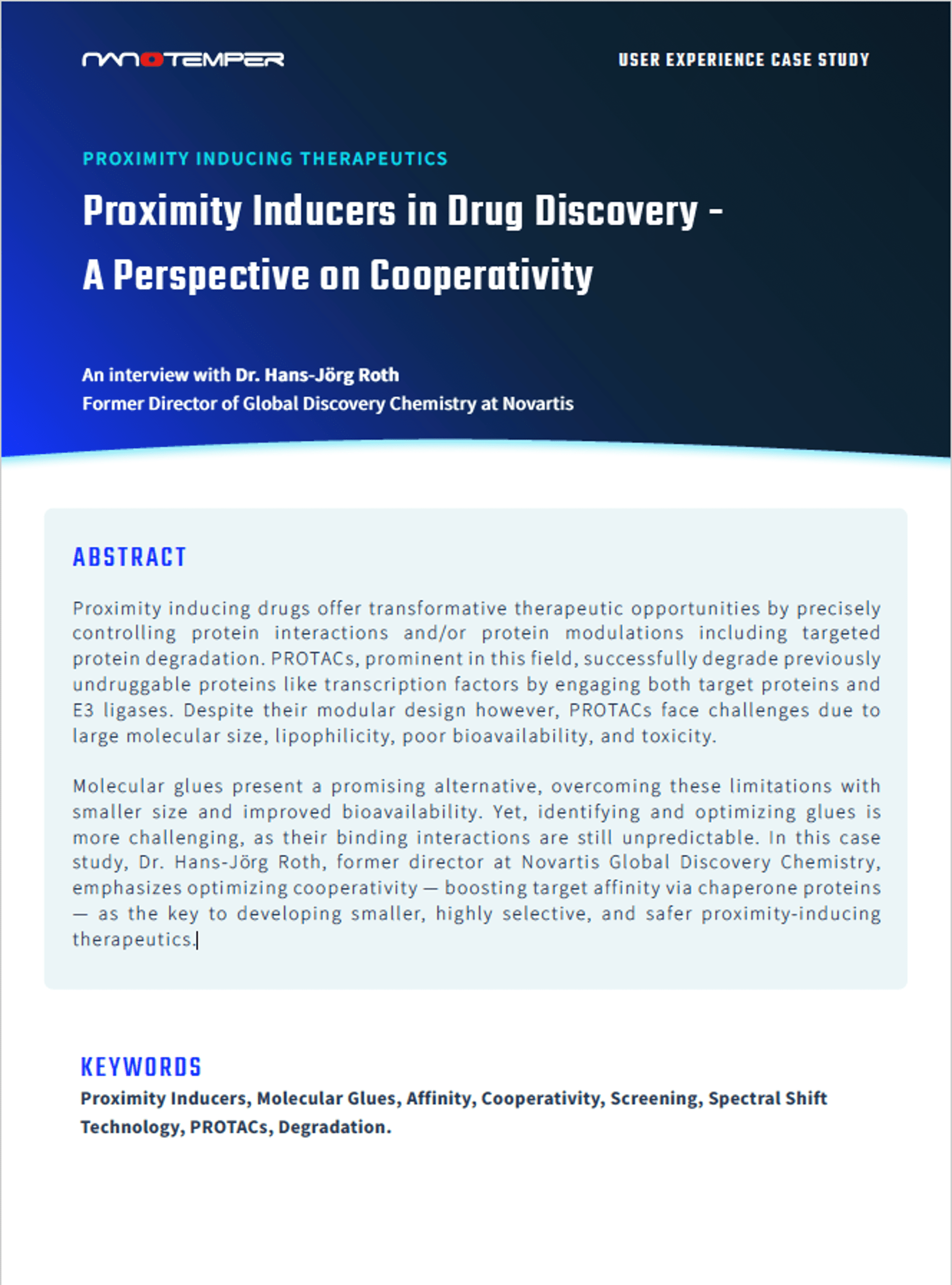PROTACs
-
 Read
ReadNanoTemper Technologies announces Dianthus α, an applications package, to push the boundaries of in-solution binding analysis.
Drug discovery teams need high-confidence data to accelerate hit-to-lead workflows and take on targets once considered undruggable.
-
 Read
Read10 Evolved Terms Every Scientist Should Know About Targeted Protein Degradation in 2025
Explore 10 advanced concepts redefining targeted protein degradation in 2025, including AI-guided design, novel degrader modalities, and tissue-specific E3 ligases for scientists working on TPD
-
 Read
ReadProximity Inducers in Drug Discovery - A Perspective on Cooperativity
-
 Read
ReadThree things we took away from attending Drug Discovery Chemistry in 2024
Drug Discovery Chemistry is an annual event that focuses solely on early drug discovery, where scientists from around the world gather to showcase their research and participate in thoughtful...
-
 Read
ReadAttend these targeted protein degradation conferences in 2024 to stay in the know
Attending dedicated targeted protein degradation conferences and tracks is a great way to keep up with this rapidly evolving field. Here are 8 conferences you’ll want to attend in 2024.
-
22:23
WatchSelective degradation of cancer target WDR5 — Evaluation of PROTACs binary and ternary affinities with Spectral Shift
Chances are your company’s research and development pipeline includes several PROTAC candidates — placing you with many others in the race to bring successful and efficient protein degraders to the cl
-
16:42
WatchHow to keep your degrader pipeline moving forward with Dianthus
The development of your protein degrader is a multi-step and complex process usually packed with challenges that if left unsolved will delay the progress of your project. What if you could overcome co
-
Read
Top 8 targeted protein degradation conferences of 2023 at a glance
Use this downloadable list of 2023 Targeted Protein Degradation conferences to choose which one(s) to attend. Learn when and where they’ll happen, who’ll be there, and the main focus.
-
Trying to characterize ternary complex formation and cooperativity?
Find out more
In-solution measurements will help -
 Read
Read8 Targeted Protein Degradation conferences in 2023 you won’t want to miss
2023 is expected to be a year of big announcements in the targeted protein degradation (TPD) therapeutics space. With more than 20 degraders in clinical trials, many decisions are coming. The race...
-
Discover tools to successfully characterize PROTAC binary and ternary complexes
Read more -
Read
How to build an effective protein degrader
-
37:25
WatchPut your challenging affinity screening campaigns back on track — after you’ve tried everything else
When you’re entrusted with developing therapeutics for challenging or undruggable targets, it’s a struggle to characterize molecular interactions. And it’s not for lack of effort or expertise — SPR an
-
59:35
WatchHow to improve the function of your PROTAC degrader by understanding ternary complex formation
Bifunctional degrader molecules (aka PROTACs) and molecular glues recruit proteins to E3 ubiquitin ligases, forming a ternary complex that enables ubiquitination and degradation of the target
-
 Read
ReadWhy so many companies are betting on PROTACs as a superior therapeutic modality
One advantage of PROTACs is their unique mode of action — the induced proximity of an E3 ligase and the protein of interest (POI) triggers the ubiquitination and then degradation of the POI by the...
-
Read
Rely on Dianthus to overcome roadblocks in your PROTAC characterizations
-
Read
Characterize your PROTAC hook effect with flexible and in-solution affinity measurements for results you can trust
-
35:47
WatchImprove your protein degrader design with new ways to discover E3 ligase ligands
Targeted protein degradation using molecular glues or proteolysis-targeting chimeras (PROTACs) is an increasingly important therapeutic modality, especially for undruggable targets. Even with candidat
-
 Read
Read10 terms to help you more easily understand targeted protein degradation
If you’re new to the world of TPD or you’re trying to keep up with all developments in this fast-moving field, here are some terms and definitions that will help you.
-
 Read
ReadProtein degraders show promising results in drug development pipelines. See progress candidates have made.
There has been considerable and promising development in the field of targeted protein degradation (TPD) since the seminal discovery of PROTACs in 2001.1 The appeal of degraders like PROTACs lies...
-
Trying to characterize ternary complex formation and cooperativity?
Find out more
In-solution measurements will help -
 Read
Read9 Targeted Protein Degradation conferences you don’t want to miss in 2022
With so much interest and investment in target protein degradation, a lot can happen in a year. Here are 9 conferences to get up-to-date on recent progress and the latest approaches. You’ll not...
-
Discover tools to successfully characterize PROTAC binary and ternary complexes
Read more -
 Read
ReadFor protein degraders to tackle neurodegenerative diseases, these are the barriers they need to overcome
The total protein degradation modality — locally and specifically targeting the disease-causing proteins and degrading their toxic aggregates — promises to be revolutionary. But the development of...
-
Loading more...



